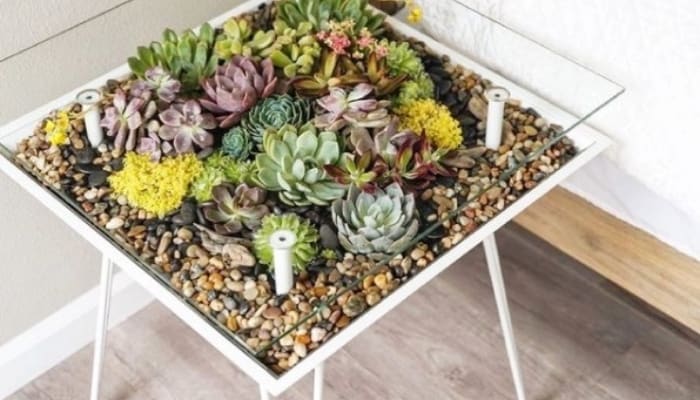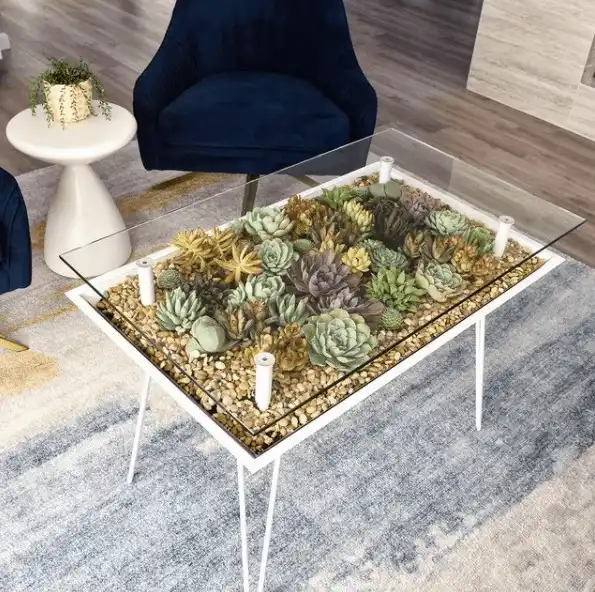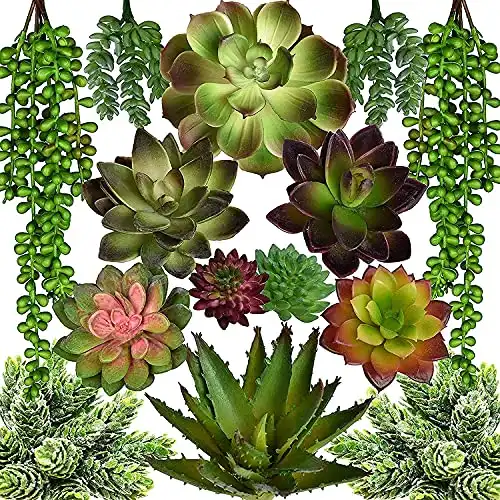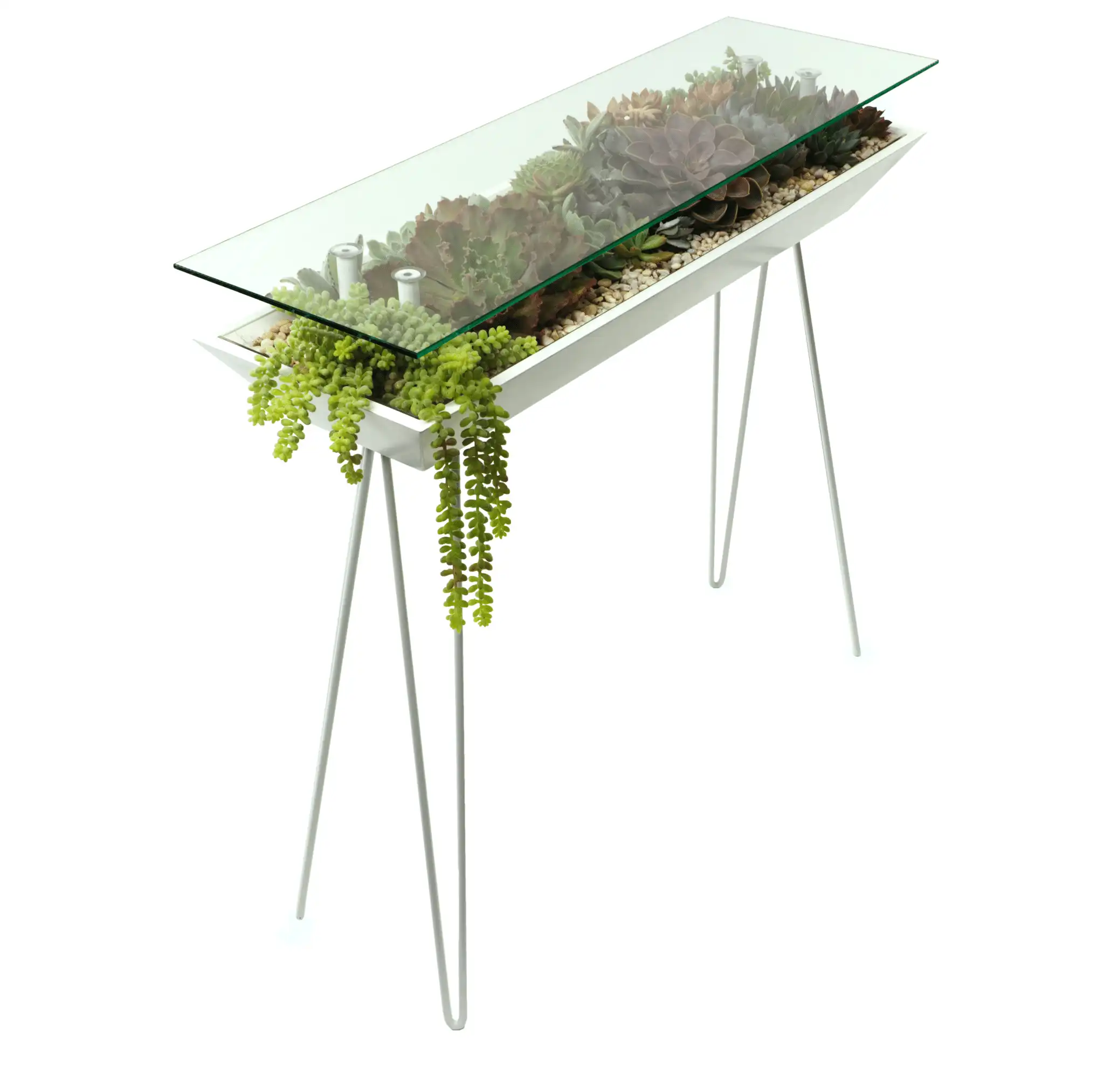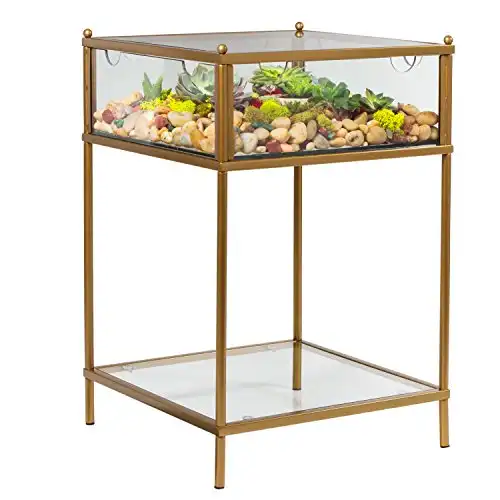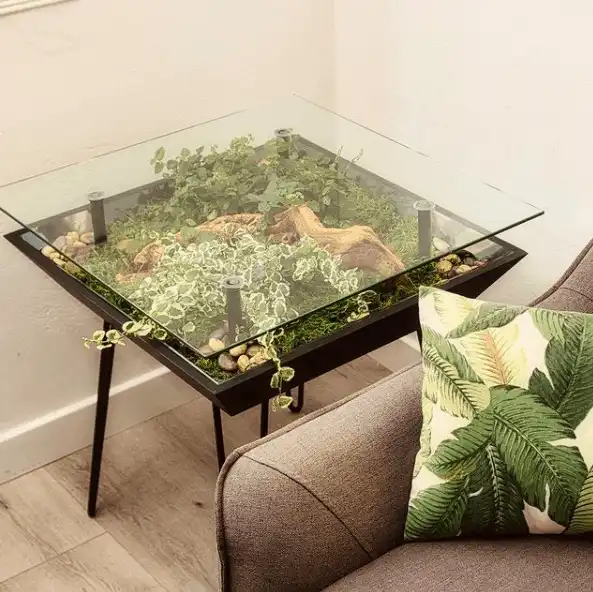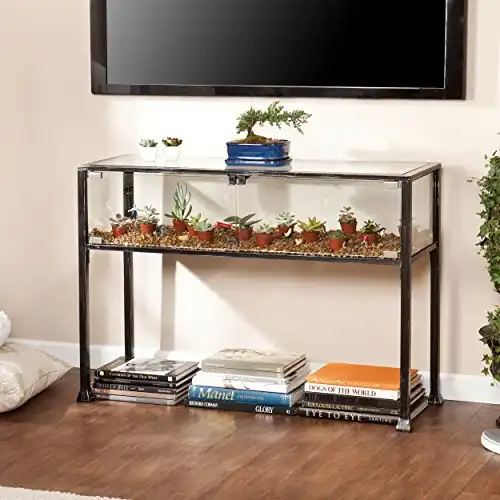Indoor plants can effortlessly add life and a splash of vibrant colors to any room.
A recent study even found that tending to houseplants has a relaxing and stress-reducing effect on people.
So it’s no wonder there’s a growing trend in people looking for unique ways to incorporate houseplants into their living spaces.
In this article, I’m going to provide you with a deep dive into Terrarium Tables.
What Is A Terrarium Table?
A terrarium table is a functional table
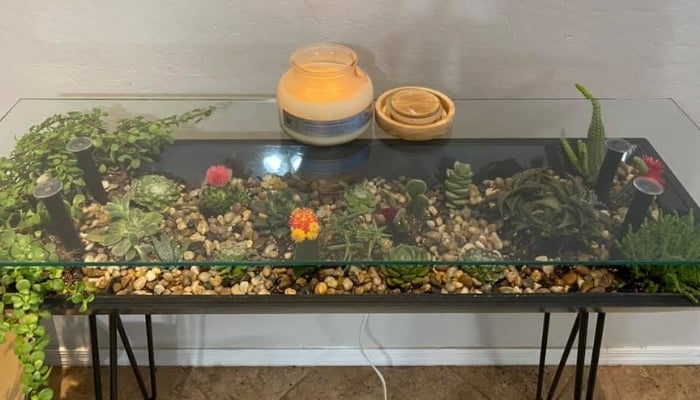
Depending on who you’re talking to, you might also hear them called living tables or succulent tables.
Regardless of what you call them, the idea remains the same – a functional table with an area to grow plants, covered by a glass top.
While many people do fill these tables with succulents, that’s not what they’re limited to.
The options for what you can put in them are only limited by your imagination (and the space you have to work with).
What Plants Are Best For Terrarium Tables?
When considering plants to include in a terrarium table, it’s important to keep in mind the distance between the growing surface and the tabletop.
For example, according to my conversation with their support team, the BloomingTables Coffee Table has roughly 7-inches of planting space between the lip/edge of the growing space and the glass top.
- White Painted Pine Wood
- 18H 35L 22W
- Waterproofing acrylic tub
- Twist-to-open drain valve
- Supports up to 400lbs
Because most tables have similar setups, you’ll want to make sure the plants you include aren’t ones that grow too tall (that’s why succulents are a popular growing option).
Succulents To Consider
- Echeveria Amoena: typically stay 4-6-inches tall
- Zebra Cactus: typically stay 4-8-inches tall
- Lithops (aka stone plants): typically stay 1-1.5-inches tall
- Haworthia Cooperi: typically stay under 2-inches tall
- String of Nickels: this is a vine variety that would hang out of the table
Leafy Plants To Consider
- Soleirolia Soleirolii (aka baby tears): another viny variety that perfect for terrariums
- Scotch Moss: typically stays under 2-inches tall and is commonly used in fairy gardens
- Tiny Boston Fern: typically stays under 2-inches tall
- Peperomia Caperata: a little on the larger size, averaging up to 8-inches tall
Cacti To Consider
- Domino Cactus: typically max out at 3-4-inches tall
- Star Cactus: short and stubby, usually reaches 2.5-inches at maturity
- Moon Cactus: typically stays under 2-inches tall
Don’t Forget Fake Plants
It might sound silly to put artificial plants into tables specifically designed for living plants, but hear me out.
You can achieve the same aesthetic with virtually zero maintenance by using fake succulents and plants.
And chances are most people wouldn’t even know. Just pick up a fake succulent combo pack on Amazon including both leafy and viny plants, and you’re set.
Plants To Avoid Growing
If you check sites like BloomingTables or Wayfair for plants they recommend growing in a living table, you’ll see them listing herbs and microgreens.
Now, I’m confident that both are possible, however, it seems like a total pain in the butt to do so. Herbs – maybe. But microgreens?
If you’ve ever grown microgreens, you know that they grow best when bottom-watered AND get kinda mess when it comes time to harvest them.
That said, I wouldn’t recommend growing either in your terrarium table (until I’m convinced otherwise, at least).
6 Things To Consider Before You Buy
Before you go dropping (potentially) hundreds on a living, growing, terrarium table, here are a few things to consider.
- Maintenence: plants need care and tending to. Make sure you’re up for the task or your table will be a brown crunchy mess.
- Safety: these tables have glass tops. If you have young children (or rowdy adults) you may need to keep them away from it.
- Size: double-check the dimensions of the table you intend to buy and ensure it fits the area you have in mind.
- Sunlight: make sure the area you intend to put your terrarium table in gets adequate sunlight or full-spectrum artificial light.
- Water: you’ll want to have access to water or a place to put a small watering can.
- Plants: I’ve included a list above of a few plants to consider. Whatever you choose, make sure they won’t grow larger than the allowed growing space of the table you choose.
Popular Types of Terrarium Tables
Of all the options out there, here is my list of the best terrarium tables on the market currently, their features, and why I like them the most. All terrarium tables should fit into the following categories.
Coffee Table Terrarium
Aside from building my own terrarium (more on that below) this is by far my favorite pre-made table.
- White Painted Pine Wood
- 34H 36L 12W
- Waterproofing acrylic tub
- Twist-to-open drain valve
- Supports up to 200lbs
Why I Chose It
I’ve gotta say, I just love the look and clean lines the BloomingTables offer, and this is no exception. They offer 7-inches of planting space from the growing bed edge to the bottom of the glass, making it easy to find plants to fill them with.
Dimensions
18″H x 35″L x 22″W
Stand-Out Features
Built-in drain for easy water monitoring and waterproof grow tub they include. Both are very helpful and show the thoughtful build quality they offer.
Drawbacks
My biggest drawback with all BloomingTables is the lack of color options. Not a big deal. If you really wanted to, you could just paint it a different color. Easy fix.
Side Table Terrariums
- 27"H x 18"L x 18"W
- Glass top for easy viewing
- Not water-tight
Why I Chose It
The square design and size make it the perfect side table terrarium. It’s not watertight, but with careful watering you should be ok.
Dimensions
27″H x 18″L x 18″W
Stand-Out Features
The thoughtfully placed airhole and bottom shelf are two things I really link with this table. I also really dig the gold finish (gold is back!).
Drawbacks
Making this table with a watertight grow area would be a big plus.
- Matte Black Painted Pine Wood
- 24H 23L 23W
- Waterproofing acrylic tub
- Twist-to-open drain valve
- Supports up to 200lbs
Why I Chose It
Clean lines and a simple design – two things I love and both incorporated into this end table.
Dimensions
24″H x 23″L x 23″W
Stand-Out Features
Definitely, the built-in drain plug. And the size – it’s a good-sized side table with plenty of planting room.
Drawbacks
A brown finish option and maybe a gray or silver color?
Entry Table Terrariums
- White Painted Pine Wood
- 34H 36L 12W
- Waterproofing acrylic tub
- Twist-to-open drain valve
- Supports up to 200lbs
Why I Chose It
As with all the tables by BloomingTables, I really love the simplicity they bring with design. They have such clean lines and the way that they have open sides makes them perfect for vining plants to spill over the edges.
Dimensions
34″H x 36″L x 12″W
Stand-Out Features
I think the built-in drain plug is a nice feature and makes for much easier watering.
Drawbacks
I do wish that they had more color options than just black and white. I will reach out to them and see if they have other colors in the works.
SEI Furniture Terrarium Entry Table
- Total Size: 42.5" W x 15.25" D x 30" H
- Terrarium Space: 40.75" W x 13.25" D x 9" H
- Not water-tight
Why I Chose It
I like this entry table because of the space it offers even though it’s probably best suited for fake succulent plants (it’s not watertight). You can probably get around this by putting a grow tray in the bottom if you really wanted to grow living plants.
Dimensions
42.5″ W x 15.25″ D x 30″ H. The terrarium space is 40.75″ W x 13.25″ D x 9″ H.
Stand-Out Features
Hands-down, the best feature is that both front doors open. This makes for easy access to the plants and is essential for an entry table that might have things sitting on top of it.
Drawbacks
I think this table would benefit from a small shelf under the terrarium. I also wish they’d designed it to be watertight.
How To Make A Terrarium Table
When it comes to anything DIY, there are many different ways to adapt the basic ideas to create a custom and unique piece that fits your style.
With terrarium tables it’s no different.
Here I’ll be sharing my favorite DIY build, including basic instructions, and a helpful video showing the table being made.
DIY Terrarium From A Display Table
This option is relatively easy as long as you can find a suitable display table to start with. You’re looking for something like this:
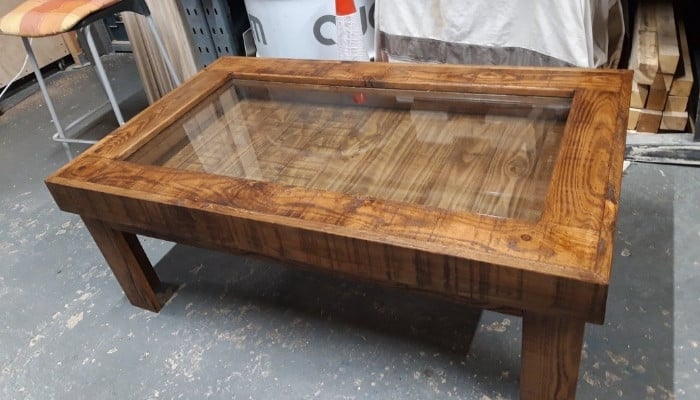
What you’ll need:
- Display table/case with a glass top (hinged top is best)
- Sandpaper / Staining supplies (optional, if you’ll be refinishing the table)
- Clear silicone caulk
- Flexseal waterproofing
Basic Steps:
- Do any sanding or refinishing to the outside of the table before working on the inside.
- Use Flexseal waterproofing or a similar waterproofer to seal the planting area of the table.
- Use silicone caulk to further seal any seams or joints.
- Once sealed, you are ready to fill with terrarium soil and begin planting.

